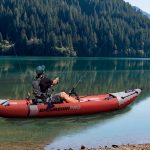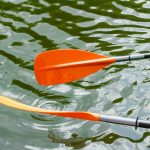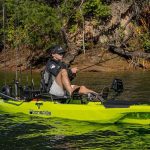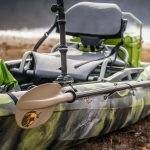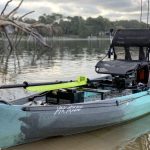Getting into kayak fishing doesn’t mean you should spend a fortune on a boat. We'll show you some impressive models you can buy for less than $500.
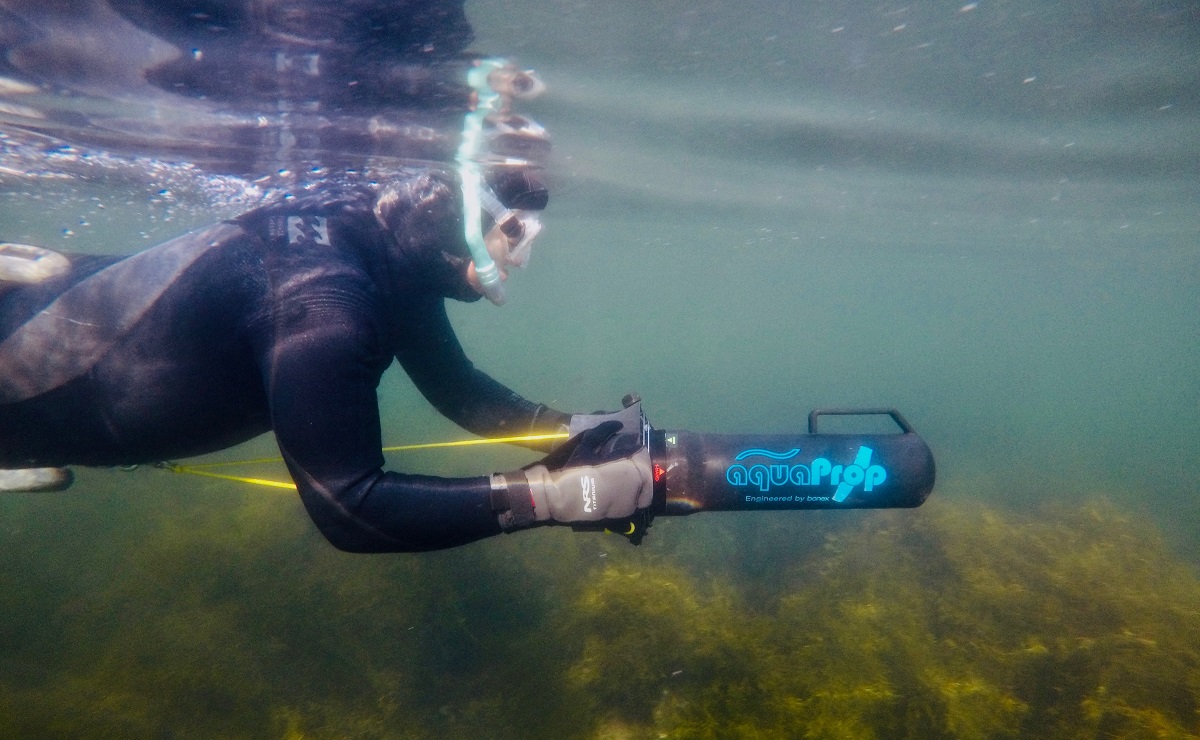
An underwater scooter, also called a “diver propulsion vehicle” (DPVs), lets you zip under water at high speeds.
Whether you’re scuba diving, snorkeling, or deep sea diving, an underwater scooter can take your underwater adventures to a whole new and exhilarating level!
In this post, I’ll share with you a list of the best underwater scooters. I’ve selected them through personal testing, extensive research, and combing through hundreds of product reviews.
I chose scooters that are well-crafted, sturdy, and reliable enough to take with you on every underwater adventure.
As an affiliate of Amazon and other retailers, we may earn a small commission when you buy via our links, at no additional cost to you. Thank you!
Quick Answer: 8 Best Underwater Scooters
Best Budget Option: WINDEK SUBLUE WhiteShark Mix Underwater Scooter
Most Versatile: LEFEET Underwater Scooter S1 Pro
Best for Scuba Enthusiasts: Scubajet PRO Underwater Kit
Most User-Friendly: WINDEK SUBLUE Navbow Smart Underwater Scooter
Most Reliable: YAMAHA Seascooter 500 Li
Best for One-Handed Operation: AQUAROBOTMAN Underwater Sea Scooter
Longest Battery Life: Apollo AV2 Evolution
Best for Kids: Yamaha Seal Seascooter
Comparison Table: Best Underwater Scooters
| Model | Specs | Where To Buy |
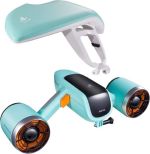 WINDEK SUBLUE WhiteShark Mix Underwater Scooter | Weight: 7.7 lbs. Depth Range: 130 ft Battery Life: 30 minutes Top Speed: 1.5 MPH | Amazon |
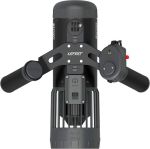 LEFEET Underwater Scooter S1 Pro | Weight: 5.5 lbs. Depth Range: 130 ft Battery Life: 35 to 70 minutes (depending on speed setting) Top Speed: 4.0 MPH | Amazon |
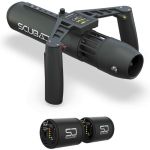 Scubajet PRO Underwater Kit | Weight: 6.6 lbs. Depth Range: 200 ft Battery Life: Up to 108 minutes Top Speed: 4.4 MPH | SCUBA |
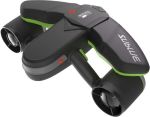 WINDEK SUBLUE Navbow Smart Underwater Scooter | Weight: 10 lbs. Depth Range: 130 ft Battery Life: Up to 60 minutes Top Speed: 4.4 MPH | Amazon |
 YAMAHA Seascooter 500 Li | Weight: 22 lbs. Depth Range: 130 ft Battery Life: Up to 90 minutes Top Speed: 4.3 MPH | Amazon |
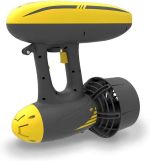 AQUAROBOTMAN Underwater Sea Scooter | Weight: 13.2 lbs. Depth Range: 164 ft Battery Life: Up to 50 minutes Top Speed: 4 MPH | Amazon |
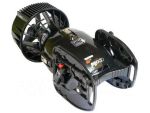 Apollo AV2 Evolution | Weight: 47 lbs. Depth Range: 230 ft Battery Life: Up to 190 minutes Top Speed: 2.8 MPH | Apollo |
 Yamaha Seal Seascooter | Weight: 15 lbs. Depth Range: 15 ft. Battery Life: 90 minutes Top Speed: 2 MPH | Amazon |
Our List of the Top-Rated Underwater Scooters
Best Budget Option: WINDEK SUBLUE WhiteShark Mix Underwater Scooter
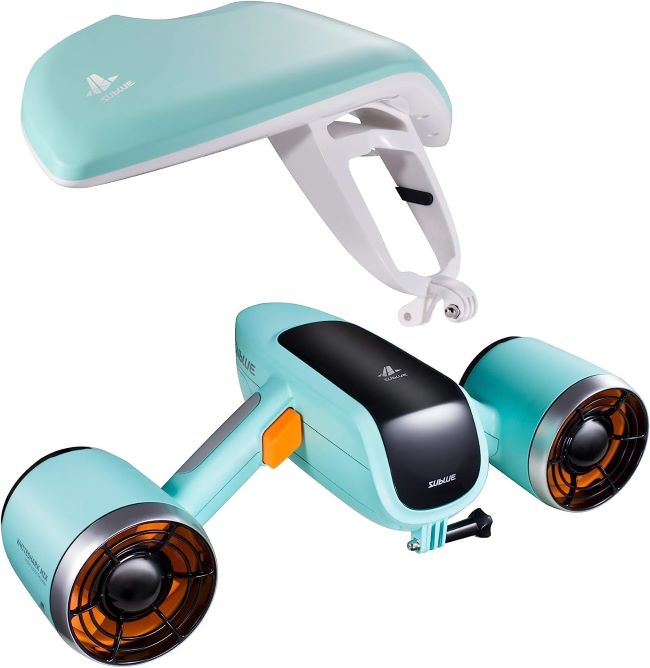
Weight: 7.7 lbs. (3.49 kg)
Depth Range: 130 ft. (40 m)
Battery Life: 30 minutes
Top Speed: 1.5 MPH (2.4 km/h)
This scooter immediately stood out from the pack as being affordable yet highly reliable.
The Sublue WhiteShark is designed for neutral buoyancy, which is perfect for snorkeling, zipping around a lake, or near-surface underwater photography.
The scooter has dual motors, which propel it at speeds up to 1.5 MPH. This is slower than some competitors on our list but fast enough for casual use in lakes, rivers, and even the ocean.
The maximum depth this scooter can go to is 40 meters (130 feet). It is tough enough to let you explore coral reefs, shipwrecks, or underwater cave systems.
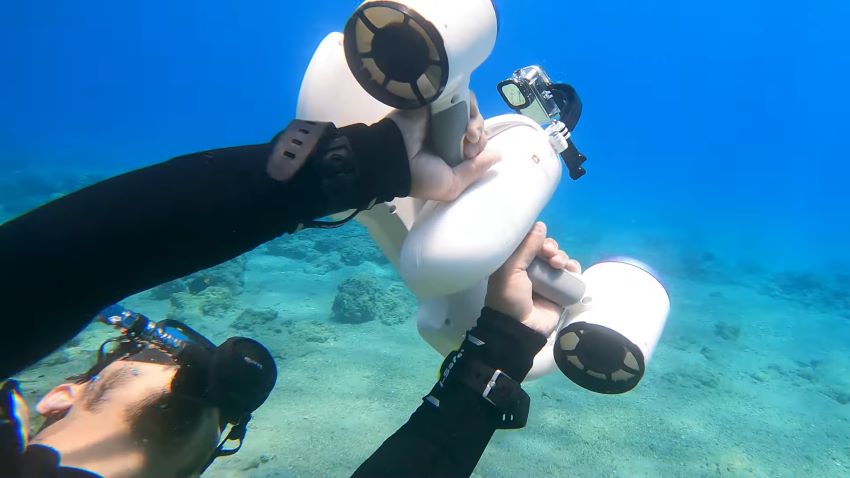
At just under 8 pounds, the WhiteShark is lightweight enough for even kids to carry it to and from the water.
I particularly liked the integrated universal interface, which is compatible with just about any action camera on the market. Now you can easily capture underwater pictures and videos.
One thing I was not impressed with was the battery. The WhiteShark comes with a 11000 mAh battery, which only lasts 30 minutes.
That being said, this underwater scooter offers amazing value for the money.
Most Versatile: LEFEET Underwater Scooter S1 Pro
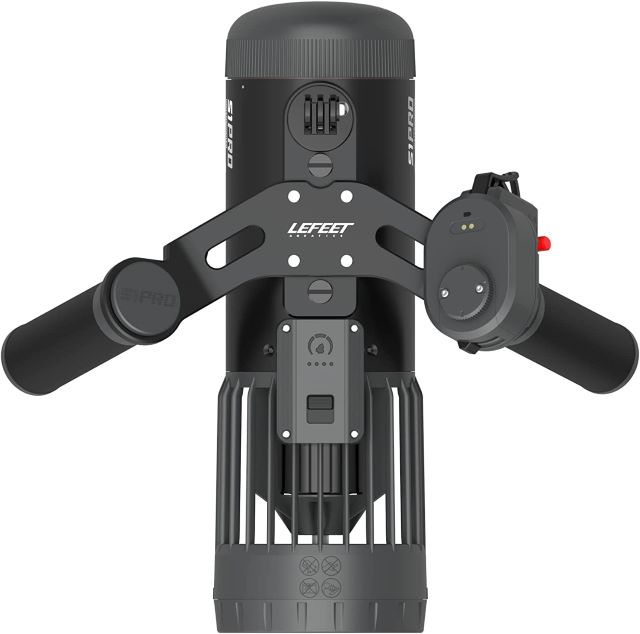
Weight: 5.5 lbs. (2.49 kg)
Depth Range: 130 ft. (40 m)
Battery Life: 35 to 70 minutes (depending on speed setting)
Top Speed: 4.0 MPH (6.4 km/h)
When testing and researching the various underwater scooter models, what I really liked about the LEFEET Underwater Scooter S1 Pro was the modular design.
You can add or remove components easily, installing propellers, handles, mounts, monitors, and more.
Basically, you’ve got total control over the functionality of this sea scooter because of how versatile the design is.
Top speed on this bad boy is an impressive 4 MPH (1.8 m/s) thanks to the 18 pounds of thrust generated by the motor.
I particularly loved the 70-minute run time, one of the longest of any DPV I reviewed.
It’s also lightweight (just 5.5 pounds) and can be disassembled or folded down small to make it portable—you can fit it into your checked luggage or carry it onto the plane with you when traveling overseas.
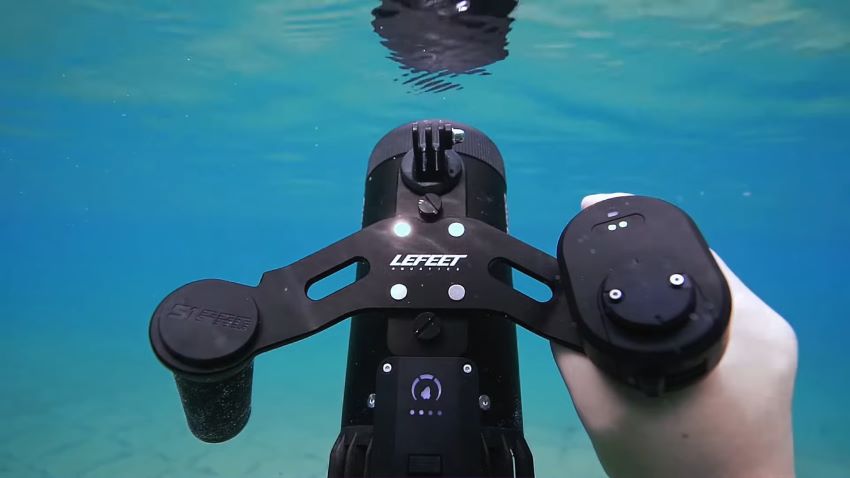
Features like three speed settings, plug-in support for action cameras, wireless control compatibility, and a depth range of up to 40 meters (130 feet) make it one of my top picks.
This scooter is built from tough aviation-grade aluminum alloy and carbon fiber composite. It features a cutting edge propeller design and excellent waterproofing.
Overall, LEFEET Underwater Scooter S1 Pro earns top marks. I think it is well worth the $800 price.
Best for Scuba Enthusiasts: Scubajet PRO Underwater Kit
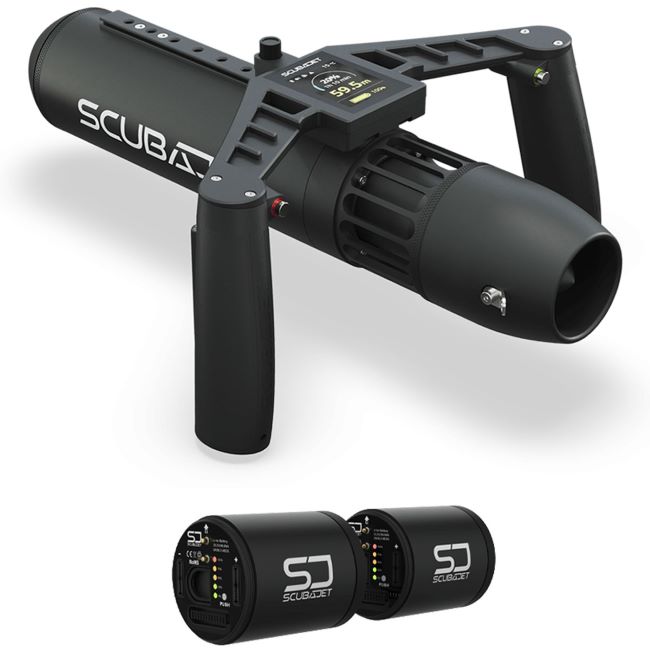
Weight: 6.6 lbs. (2.99 kg)
Depth Range: 200 ft. (61 m)
Battery Life: Up to 108 minutes
Top Speed: 4.4 MPH (7 km/h)
If you plan to go scuba diving, this handy DPV will make a great addition to your equipment. Admittedly, it’s on the pricier side, but it’s a worthwhile investment nonetheless. After all, the 200-foot depth range, 4.4 MPH (2 m/s) speed, and nearly two-hour run time (108 minutes) makes it a piece of gear any deep-sea scuba diver will be proud to own and operate.
The DPV comes with a few very useful features: a modular design that lets you customize its function, eco-friendly technology that prevents it from harming marine life, a compact-yet-highly powerful 1000W motor, auto shutoff, “smart batteries”, and wireless connection compatible with third party apps.
It’s corrosion-resistant, fully waterproof, sturdy, and requires virtually no maintenance. Really, the only thing I didn’t like about this underwater scooter was its limited availability. Despite the high price tag, it’s sold out more often than not.
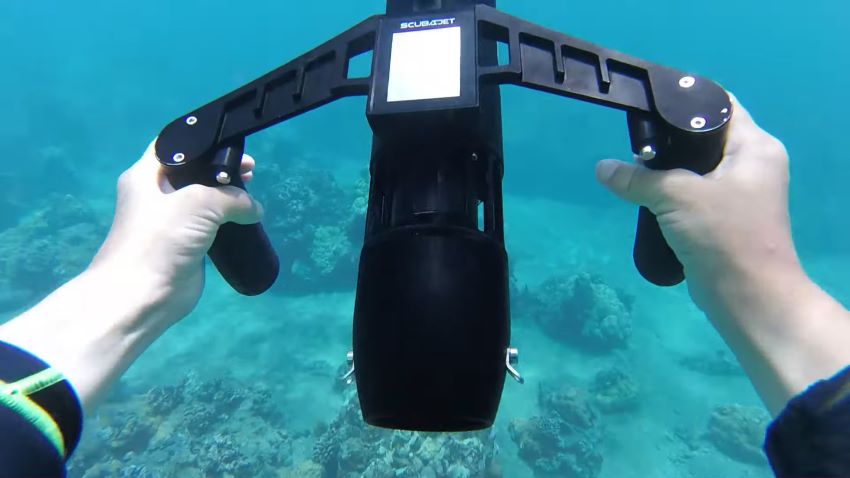
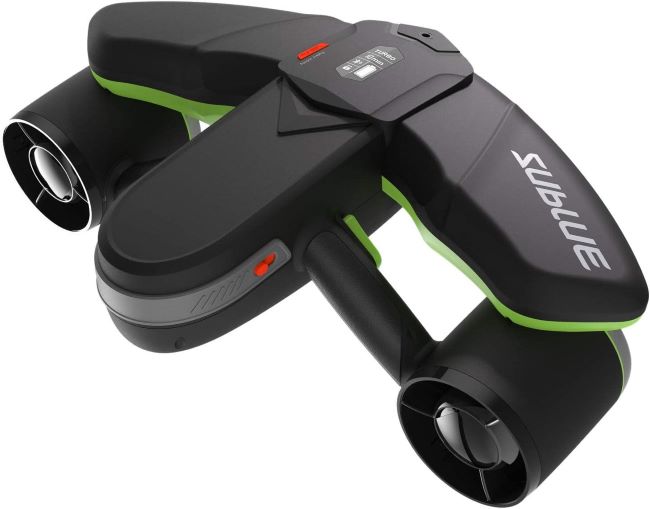
Weight: 10 lbs. (4.54 kg)
Depth Range: 130 ft. (40 m)
Battery Life: Up to 60 minutes
Top Speed: 4.4 MPH (7 km/h)
If you’re looking for a sea scooter that’s pretty much “plug and play”, this is the one I liked best for its hassle-free, no-maintenance design.
In terms of performance, it’s a step up from our top pick: a 4.4 MPH top speed, battery life of up to 60 minutes, and OLED display showing you details like speed and battery life. It’s also a big step up in price, though, so prepare for a larger investment.
I particularly liked the design, which allows for both two- and one-handed control, as well as the addition of a tow cord so I never had to worry about losing it to the ocean’s currents or slowing down when releasing the trigger to take a picture. The universal interface is compatible with not only action cameras, but also balance weights and lights.
One major dislike, however, was the not-quite-waterproof battery compartment. Though the manufacturer says it won’t damage the battery, it still left me a bit leery and worried long-term water exposure could lead to operational problems. And at 10 pounds, it’s one of the heavier underwater scooters I reviewed.
Most Reliable: YAMAHA Seascooter 500 Li
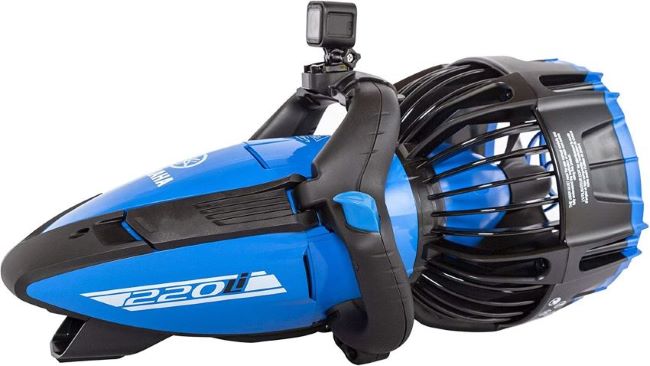
Weight: 22 lbs. (9.98 kg)
Depth Range: 130 ft. (40 m)
Battery Life: Up to 90 minutes
Top Speed: 4.3 MPH (6.9 km/h)
With the YAMAHA Seascooter 500 Li, you get a truly reliable sea scooter that needs virtually no maintenance or upkeep. In fact, save for a rinse to clean off salt water and changing out the Li-ion battery pack (after years of use), you should easily get 10+ years of operation from this reliable DPV.
The 500 LI model packs a larger battery pack and more powerful motor, delivering top speeds of 4.3 MPH and run times as long as 90 minutes. The depth rating is roughly average (130 feet), but the construction is solid and features like a battery level indicator and three speed settings made it one of our favorite options.
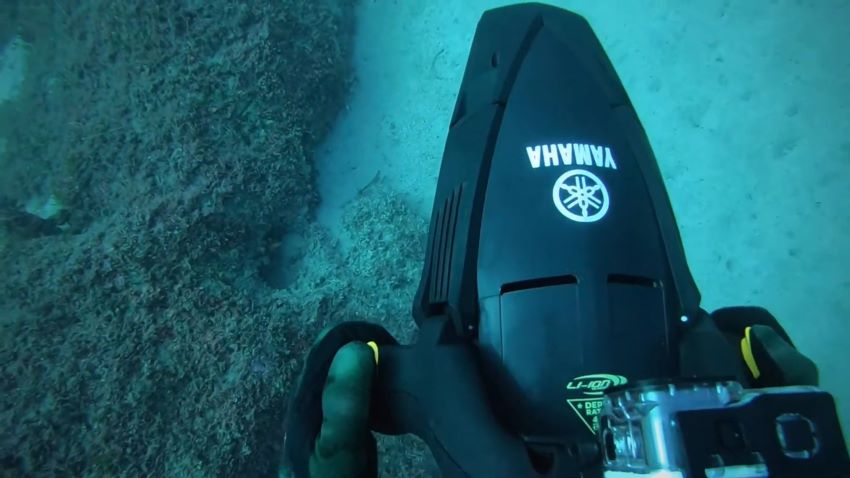
I particularly liked the automatic buoyancy adjustment system, which allows it to float on or near the surface as desired. My research also discovered that the Lithium ion battery is the longest-lasting and best-performing for any underwater scooter in its category. Be aware, though, that it’s definitely a heavier DPV—a whopping 20+ pounds.
Best for One-Handed Operation: AQUAROBOTMAN Underwater Sea Scooter
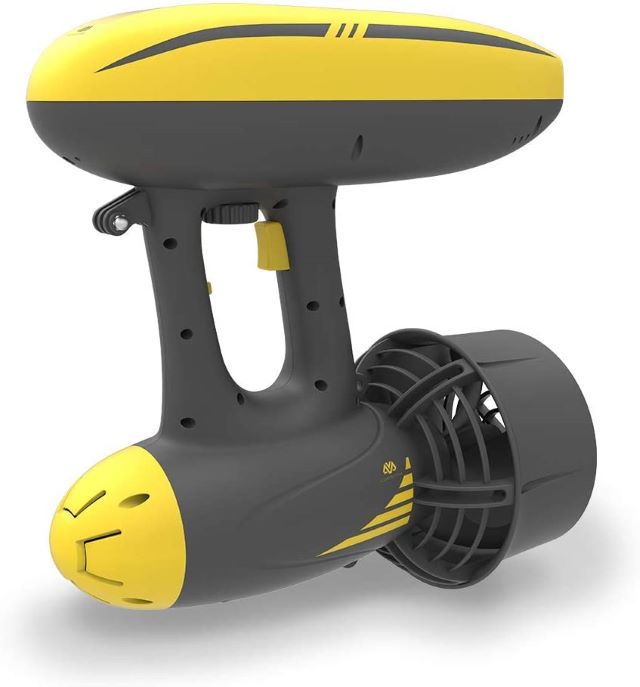
Weight: 13.2 lbs. (5.99 kg)
Depth Range: 164 ft. (50 m)
Battery Life: Up to 50 minutes
Top Speed: 4 MPH (6.4 km/h)
For underwater photographers, videographers, snorkelers, and spear fishers, this is the sea scooter for you. It’s designed specifically for one-handed operation, with just one grip and one trigger, and power enough to keep you zipping through the water at above-average speeds (4 MPH, or 1.8 m/s).
The depth rating of 50 meters (164 feet) makes it better suited to the ocean’s depths than most of the other underwater scooters we reviewed. Even when dealing with greater water pressure in the deeps, we liked how it maintained power and didn’t significantly lose speed.
One major “pro” I found: the DPV comes with three camera mounts, which allows for multiple cameras to capture footage and images from a wide range of angles. With one hand gripping the trigger and keeping you moving, you’ve got a hand free to snap pictures and record video as desired.
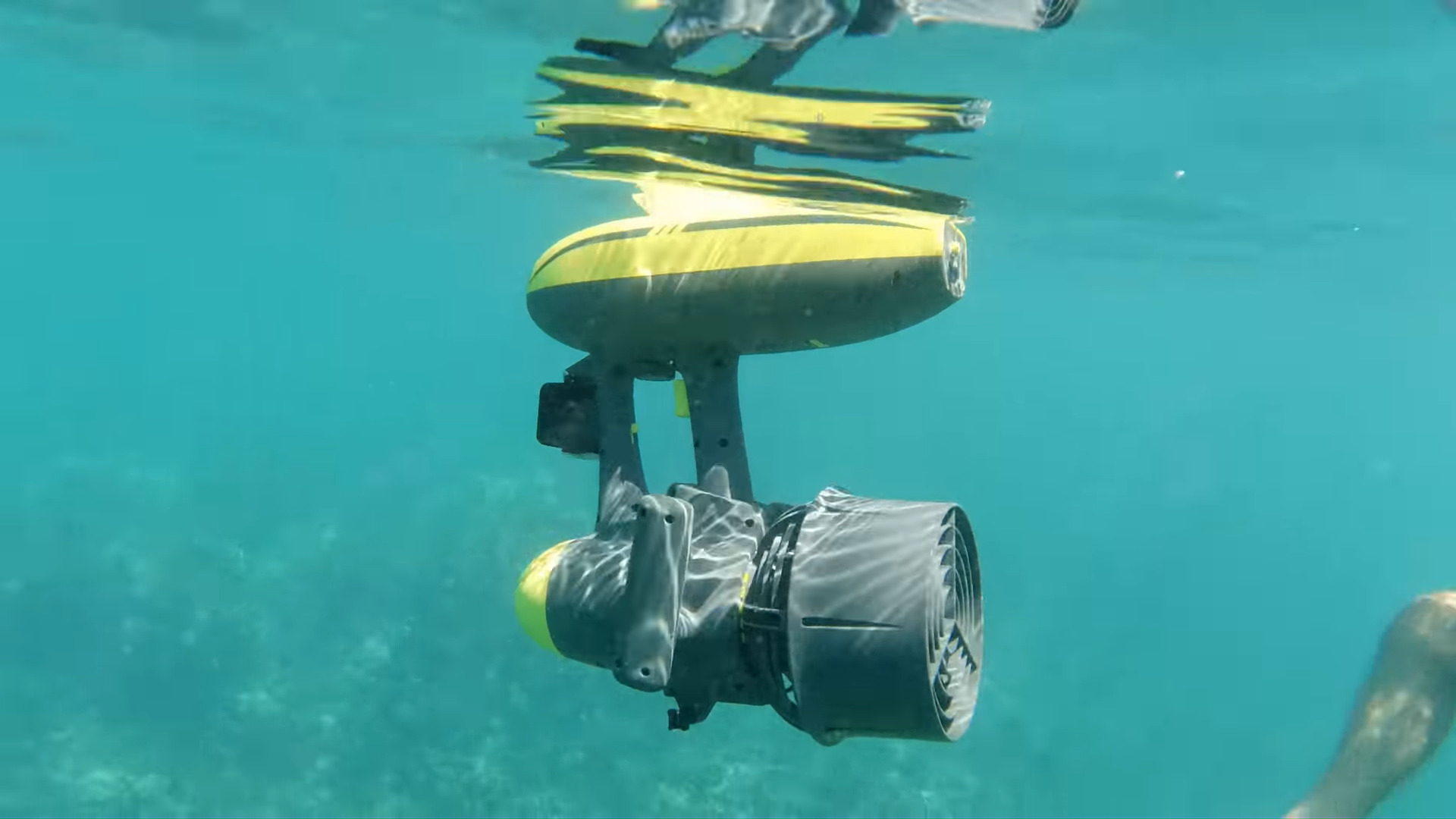
The underwater scooter is only backed by a 1-year warranty, which has me concerned that it’s not the most durable option on the market. It’s also very positively buoyant and highly likely to pull you toward the surface, which makes it less-than-ideal for deeper water.
Longest Battery Life: Apollo AV2 Evolution
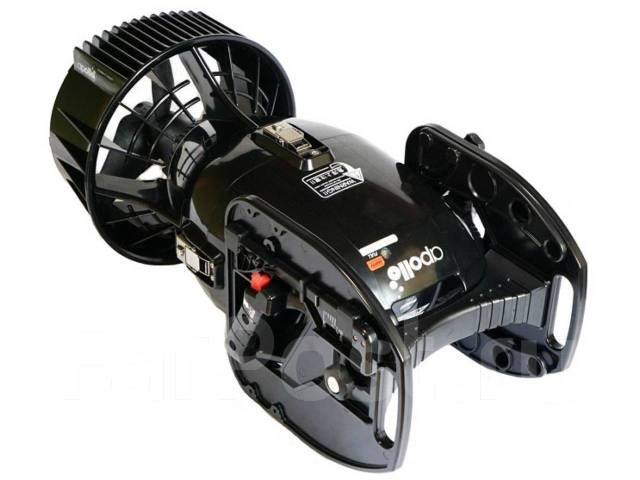
Weight: 47 lbs. (21.32 kg)
Depth Range: 230 ft. (70 m)
Battery Life: Up to 190 minutes
Top Speed: 2.8 MPH (4.5 km/h)
For anyone who plans to spend a lot of time submerged and exploring deep underwater, I recommend the Apollo AV2 Evolution because of its ultra-long battery life: a whopping 190 minutes (more than 3 hours!).
There’s a lot I liked about this particular DPV: a depth rating of up to 230 feet, three speeds controlled by a variable speed trigger, a sturdy shock-resistant body, and the option to add a hands-free riding saddle. Though it doesn’t go as fast as many of the others I reviewed (just 2.8 MPH), it’s got power enough to pull plenty of scuba diving and other underwater gear.
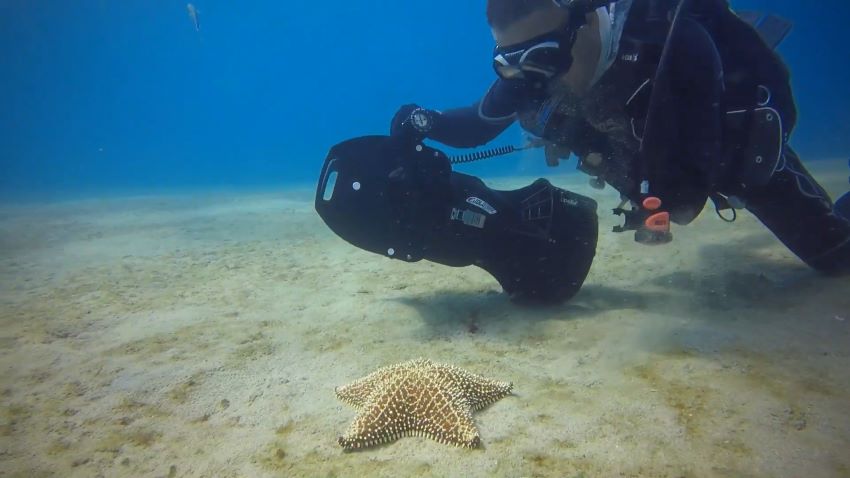
However, be aware that this is very much priced in the “professional” range. It’s far from the most affordable option on our list, best suited to those who need a premium quality piece of equipment for work rather than for play. And at a whopping 47 pounds, lugging this to and from your vehicle is no joke!
Best for Kids: Yamaha Seal Seascooter
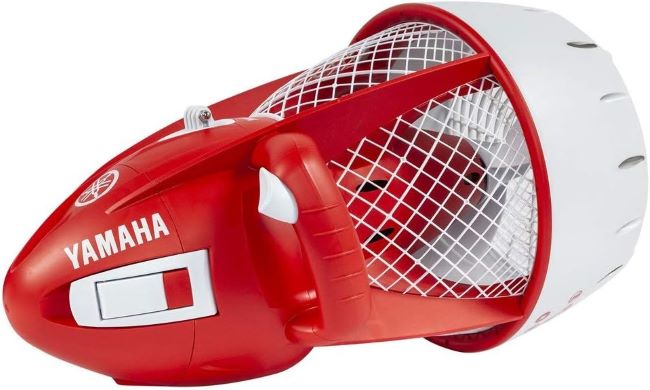
Weight: 15 lbs. (6.8 kg)
Depth Range: 15 ft. (4.6 m)
Battery Life: 90 minutes
Top Speed: 2 MPH (3.2 km/h)
Given that the Yamaha Seal Seascooter is built specifically for kids, it’s no surprise that it’s neither the speediest nor sturdiest on our list. It’s rated for depths of just 15 feet (4.6 meters) and can only reach top speeds of 2 MPH. However, I loved the fact that Yamaha offers a whopping 90-minute battery life to match the stamina of even the most energetic kids.
The DPV comes with an integrated mount for action cameras, letting your kids take their GoPro into the water and capture underwater videos and images to their hearts’ content. Features like auto shut-off, caged propeller casings, and dual-trigger controls makes it fully safe for all swimming-age kids to use.
One thing about this sea scooter I didn’t like was that the sealed acid lead battery needs maintenance every 3 months in order to maintain its charge. One more toy/piece of gear for busy parents to worry about in addition to all the other watersports equipment. Plus, at over 15 pounds, I found it’s a bit too heavy for all but the strongest kids to lug to and from the water.
Factors to Consider When Shopping for Underwater Scooters
Don’t make the mistake of buying the first underwater scooter you see!
With so many options on the market, it’s important to consider all the factors that go into choosing the “right” underwater scooter for you.
Let’s break it down…
Intended Use
Underwater scooters are used for a number of different purposes:
- Deep-sea diving
- Snorkeling
- Free-dive training
- Cave and wreck diving
- Scuba diving
- Underwater photography
- Racing (yes, this is very much a thing!)
Which scooter is “right” for you will depend on what you need it for.
For example, if you’re going to be deep-sea diving, you may want a sturdier scooter that can handle the pressures of the deep ocean. For cave and wreck diving, you might consider a longer run time a more useful feature. For underwater photography, you might prefer user-friendly controls that can be operated with one hand, leaving the other free for operating your camera. And for racing, speed is definitely the most important factor, but battery life comes in a pretty close second.
Consider what you plan to use the DPV for, and shop accordingly.
Construction
The sturdier the construction, the longer the underwater scooter will last.
Typically, underwater scooters are made using high-strength plastic polymer exteriors and corrosion-resistant stainless steel or marine-grade aluminum for any metal hardware. However, the toughness of their materials is just the beginning.
You want to make sure the underwater scooter is built to withstand high pressures (if you’re planning to take it diving to any significant depth) as well as fully waterproofed to protect the delicate internal electronic components.
It’s always worth reading product reviews to see what real-life users thought of the DPV’s durability and construction. If it’s well-built and lasts for years, customers are going to be happy to talk about it. And the same is very true if the underwater scooter is poorly built, breaks easily, or leaks.
Speed
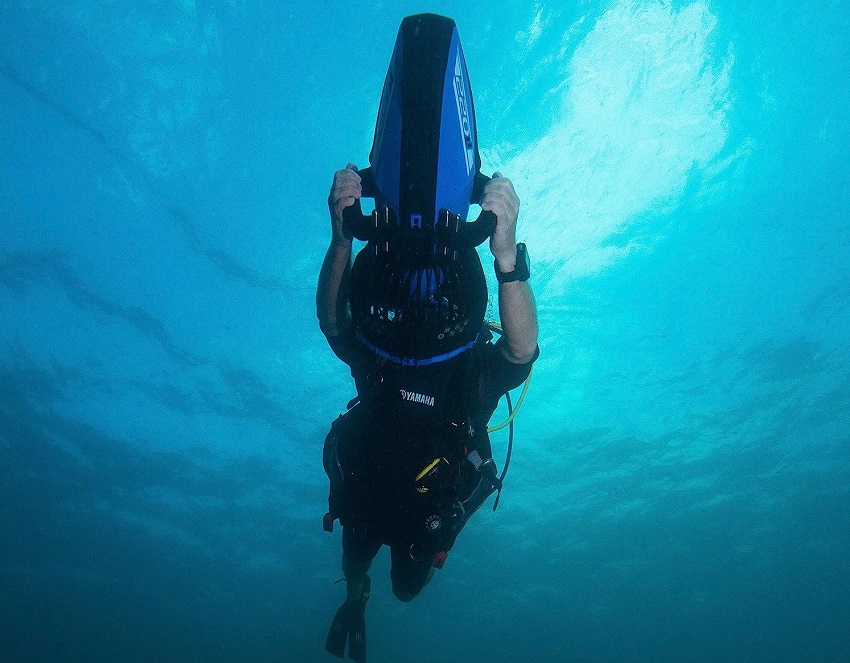
Underwater scooters are built to operate in roughly a 1.5 to 4.5 MPH speed range. This may not sound like a huge range, but trust me, there’s a big difference between the lowest and highest speeds. You’ll feel it when zipping along, racing around rocks, or chasing fish.
The speed of the scooter will be determined by a number of factors, including:
- Motor power
- Unit weight
- Gear weight
Be aware that the faster DPVs tend to be significantly more expensive than the slower ones, because they need to pack larger, more powerful motors. They may also be heavier because the motors end up being larger to produce more power.
If you’re racing, speed is definitely a prime factor to look for. But if speed isn’t absolutely necessary, most of the “affordable” and “mid-tier” sea scooters are roughly in the 1.5 to 2 MPH range.
Depth Range
The depth range of the scooter (how deep it’s rated to dive, and how much pressure it can withstand) will determine what you can use it for.
For example, an underwater scooter that’s rated for 10 or 20 meters may be useful for snorkeling, underwater photography, and racing, but will likely give out if you try to take it deeper for deep-sea diving, cave diving, or wreck diving.
As you saw on our list of the scooters above, depth range can be quite varied—anywhere from 15 feet to 300 feet. Make sure to choose a scooter that’s rated to go as deep as you plan to, so you can trust it’ll withstand the pressure of the ocean’s depths.
Buoyancy
This is a very cool feature, one that can be quite handy for divers, both newbies and experts.
Scooters set to negative buoyancy are designed to sink. This makes them ideal for diving deep, as the weight of the scooter will pull you downward. However, be aware that if you lose your grip on the scooter, it will sink (unless it’s secured to you by a lanyard or wrist strap). The weight may also pull you downward and could make it more difficult to resurface in an emergency.
Scooters set to positive buoyancy are designed to float. This may be ideal for those who are working or swimming nearer the water’s surface, such as wreck divers (with air pockets), underwater photographers, or snorkelers. The air tanks incorporated into the DPV’s design will pull you toward the surface, which can be great for newbies who are still getting used to deeper depths. However, experts may not like being constantly pulled upward.
A very cool (and often pricey) feature of some higher-end underwater scooters is the ability to set your preferred buoyancy (positive, negative, or null) or make adjustments to the buoyancy in the water. Some also feature auto-buoyancy settings that adapt the buoyancy to your use.
Ease of Use
The easier the DPV is to use, the safer it will be for you to operate it in rough ocean currents, underwater caves, and submerged wrecks. One-handed controls make it easy for you to capture underwater photographs or adjust your scuba gear as necessary.
The fewer buttons, dials, levers, and features you have to worry about, the easier it is to operate the sea scooter underwater. On the other hand, a DPV with more controls may have a steeper learning curve, but will give you more control over the vehicle.
It’s up to you to decide how complex or simple you want the operations to be!
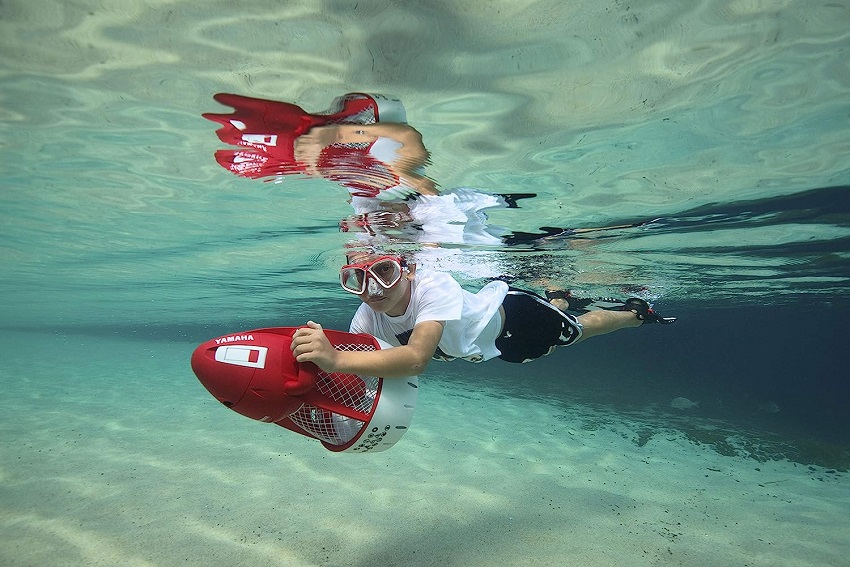
Battery Life
The cheapest of the sea scooters will have a battery run time of around 30 minutes. Not bad if you’re snorkeling with buddies or want to snap some underwater pictures, right?
But if you’re deep-sea diving, cave diving, wreck diving, or racing, you’ll likely need a longer battery life.
Thankfully, as you get into the mid and higher tiers, battery life will increase—to 60 minutes, 90 minutes, or even as much as 2 hours.
How much battery life you need will depend on what you plan to use it for. Just remember that once the battery is depleted, you’ll have to swim the DPV back to the shore, dock, or your boat without the aid of the motor. (This is where the buoyancy setting matters! Trying to swim with a drained DPV set to negative buoyancy is no easy task.)
Weight
The weight of the underwater scooter may not matter too much when you’re in the water, because it’s built to utilize the integrated buoyancy settings (as you saw above) to rise, sink, or float.
However, it’s when you’re out of the water that the weight matters. That’s when you’re going to have to lug it back and forth between your vehicle and the water/dock/boat.
But the weight will also be a factor if you run out of battery life and have to swim carrying the weight of the sea scooter. A heavy DPV may be too much for you to handle in certain conditions.
DPVs come in a variety of weights—some as light as 2-3 pounds, while others can be upwards of 10 pounds. Typically, the more power a sea scooter has, the larger its motor and propeller (and possibly even the battery pack), so the heavier it’ll be. The lighter underwater scooters tend to be the ones with lower power/top speeds.
Safety Features
Operating a sea scooter isn’t inherently dangerous, but the ocean around you can be. That’s why so many underwater scooters come with features added specifically for your safety, including:
- Lanyard, to keep the DPV from sinking or you from floating away if you release your grip on it.
- Detachable floaters, which offer positive buoyancy but can be detached when you want to dive deeper.
- Display panel that shows you a readout of data like speed, battery life, or remaining run time.
- Full user control, with no risk of auto-starting or auto-speeding up.
- Auto shut-off button to switch the scooter off when you release the trigger.
- Safety cage or net over the propeller to protect your fingers.
It’s also highly recommended that you run a safety check before taking it out into the water, testing its operation, battery life, and checking for any signs of leakage or damage.
Action Camera Mount
This is a very handy feature to look for on sea scooters built for underwater photography or videography. After all, mounting your action camera directly onto the DPV will make it much safer and easier to capture images/video than operating your DPV one-handed and trying to hang onto and use your camera with the other.
Plus, an integrated mount will provide you with a safe, convenient place to secure your camera while swimming.
You’ll typically find this feature on DPVs suitable for shallower depths rather than deep sea diving underwater scooters. After all, the average action camera is only rated for a few meters (10 meters, in the case of the GoPro Hero) and can only stay submerged for 30 minutes.
Maintenance Required
Let’s be honest: every machine is going to need at least a little maintenance. Whether it’s simply cleaning saltwater out of all the cracks and crevices, tuning up the motor, or regularly checking the battery life, any sea scooter you own will require some maintenance.
At the same time, unless you’re an expert in electronics, motors, and mechanics, you’re probably not the best person to be tinkering around with the DPV’s complex internal systems.
Thankfully, the user manual will usually list what maintenance is required from you, and how frequently it’s needed. The less maintenance necessary, the better.
Warranty
A good warranty is worth its weight in gold!
The best-rated DPVs are built to operate reliably for years of regular use. Ideally, they’d outlast their 1, 2, or 5-year warranty. A well-constructed, sturdy sea scooter will run for years without your ever needing to take advantage of the coverage provided by the manufacturer’s warranty.
But there is always the risk of quality control issues that allow one defective part to be installed on the sea scooter, or some manufacturing flaw to be missed. In that case, having the warranty is the best way to make sure you can get the damaged part (or the entire DPV, if necessary) replaced hassle-free and at no extra cost to you.
Price
Price is a factor to consider, but only as it relates to the quality of the underwater scooter.
“Higher quality = higher price” is a pretty safe bet when it comes to DPVs, though it’s not a hard-and-fast rule. You may find some of the costlier models are less reliable than the lower-priced models. That’s why it’s imperative to research not only the price tag, but also the features, specifications, and the performance (based on real-life customer reviews).
Expect to pay anywhere from $250 to $1,000 for the “budget” models, and $1,000 to $4,000 for the higher-end and “professional-grade” underwater scooters.
Underwater Scooter FAQs
Underwater scooters are as safe as their operator—that is to say, if you’re properly trained in their use and operate them as they are intended, they will be perfectly safe both for you and any marine life you may encounter.
Warranties on sea scooters will usually range between 12 months and 5 years, though some pro-grade models may have a warranty up to 10 years. It’s safe to expect the DPV to last anywhere from 25% to 100% longer than the length of the warranty. Bear in mind, though, that with proper maintenance and care, a sea scooter may last for decades without needing to replace more than a few parts.
Sea scooters are wonderful for snorkeling! They allow you to cover a lot more underwater area and see more coral reefs, rock formations, shipwrecks, and marine creatures. You’ll want to find a DPV set to “positive” or “null” buoyancy so it won’t pull you deeper, but keeps you close enough to the water’s surface for you to breathe through your snorkel.
The average depth range is anywhere from 30 meters to 200 feet. However, some (such as Sub Gravity’s AquaProp L or TUSA’s SAV-7 EVO3) are capable of greater depths. If you plan to dive deeper than 200 feet, you’ll want to look specifically for DPVs rated for higher water pressure with longer battery lives and greater depth ranges.

